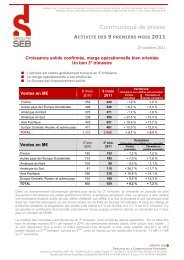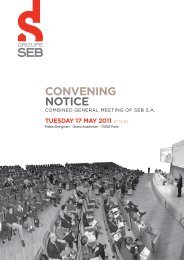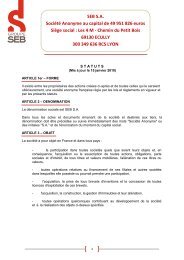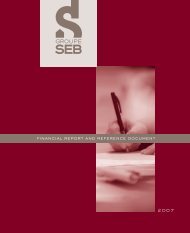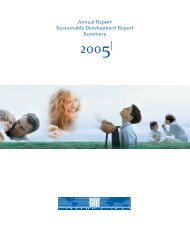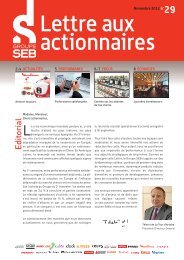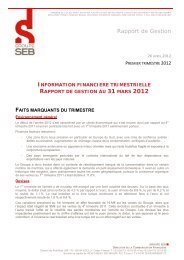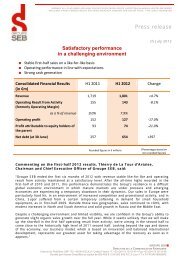financial report and registration document 2011 - Groupe SEB
financial report and registration document 2011 - Groupe SEB
financial report and registration document 2011 - Groupe SEB
Create successful ePaper yourself
Turn your PDF publications into a flip-book with our unique Google optimized e-Paper software.
2 Chairman’s<br />
Corporate governance<br />
<strong>report</strong> on internal control<br />
This centralisation of operations allows the Finance department to:<br />
� control external debt <strong>and</strong> monitor its development;<br />
� manage the risk rate inherent in the contracted debt;<br />
� fi nance its subsidiaries in their local currency where regulations permit;<br />
� anticipate <strong>and</strong> manage currency risk inherent in commercial <strong>and</strong> fi nancial<br />
fl ows.<br />
Another important element of internal control is the Group’s centralised<br />
choice of working-partner banks <strong>and</strong> effective long-term management of<br />
these relations.<br />
This organisation enables the Finance department to ensure overall control<br />
of the Group’s treasury operations.<br />
CONSOLIDATED ACCOUNTS MANAGEMENT<br />
AND CONTROL<br />
We have already described the role of Group Management Control in<br />
overseeing monthly consolidated fi nancial management information.<br />
Budgetary control identifi es deviations from performance targets, on the<br />
basis of monthly consolidated data which is compared to an analysis of<br />
Group operational directives. This makes it possible to identify any changes<br />
or discrepancies in relation to fi nancial budget data <strong>and</strong> previous years.<br />
This decentralised statutory consolidation includes all the companies in<br />
the Group that are directly or indirectly controlled by the Group’s holding<br />
company, <strong>SEB</strong> S.A.<br />
Each consolidated subsidiary prepares a set of accounts, restated to comply<br />
with the Group’s accounting procedures <strong>and</strong> based on accounting data from<br />
local information systems. All the Group’s entities apply IFRS accounting<br />
st<strong>and</strong>ards.<br />
The Finance Managers of the subsidiaries prepare the restated accounts on<br />
the basis of the Group’s accounting procedures h<strong>and</strong>book, which sets out<br />
rules for accounting entries <strong>and</strong> evaluation.<br />
This h<strong>and</strong>book describes the principles used to draw up fi nancial statements.<br />
The principles cover areas such as preparation of accounts on the assumption<br />
of operational continuity, compliance with accounting periods, <strong>and</strong> ensuring<br />
the integrity of the information in the fi nancial statements. It is regularly<br />
updated to integrate changes in legislation <strong>and</strong> regulations governing the<br />
preparation of consolidated accounts in France.<br />
The accounting procedures h<strong>and</strong>book also gives a precise description of<br />
the principles used by the Group for accounting entries, <strong>and</strong> evaluation <strong>and</strong><br />
presentation of the main items in the fi nancial statements:<br />
� descriptions of constituent items of the consolidated income statement<br />
with their defi nitions, as well as consistency tests for the purpose of<br />
taxation;<br />
� rules governing balance sheet <strong>and</strong> off-balance sheet items <strong>and</strong> their<br />
presentation;<br />
� regulations concerning the valuation of certain estimated items, such as:<br />
� provisions for the impairment of receivables,<br />
� provisions for the impairment of stocks of raw materials <strong>and</strong> fi nished<br />
products,<br />
� provisions for the impairment of non-current assets,<br />
� provisions relating to sales (e.g. warranties <strong>and</strong> unsold returns),<br />
� other provisions for risks <strong>and</strong> charges <strong>and</strong> in particular, provisions for<br />
restructuring;<br />
� accounting principles applied to <strong>report</strong>ing intra-Group transactions.<br />
Prior to each consolidation period, the Group Consolidation department<br />
issues a reminder of the <strong>report</strong>ing deadline <strong>and</strong> indicates any newlyapplicable<br />
changes in st<strong>and</strong>ards, rules <strong>and</strong> principles.<br />
On receiving the sets of accounts for consolidation, the Group Consolidation<br />
department conducts the usual verifi cations before carrying out the actual<br />
consolidation. This review of the accounts submitted is an opportunity to<br />
verify the evaluation <strong>and</strong> accounting methods used for large, unusual or<br />
exceptional transactions.<br />
To ensure the integrity of the fi nancial data received from the subsidiaries,<br />
the Group Consolidation department refers to the covering letter sent in by<br />
the management of each subsidiary (whether or not consolidated), at the<br />
time of closure of the half-yearly <strong>and</strong> annual accounts. In this covering letter,<br />
the offi cial representative <strong>and</strong> the Finance Director of the entity concerned<br />
jointly certify the compliance of the fi nancial statements with the Group’s<br />
accounting rules <strong>and</strong> principles, the effectiveness of the internal control<br />
procedures used to process <strong>and</strong> draw up the fi nancial statements <strong>and</strong> the<br />
absence of irregularities involving personnel or management. In addition,<br />
they comment on any signifi cant events occurring during the accounting<br />
period under review <strong>and</strong> describe all elements which, in themselves or in their<br />
overall effect, infl uence the comprehension <strong>and</strong> evaluation of the fi nancial<br />
statements of the entity concerned.<br />
FINANCIAL COMMUNICATION<br />
The Group’s fi nancial statements, accounts <strong>and</strong> notes to the accounts are<br />
drawn up on the basis of the fi nal data processed by the consolidation<br />
software. These are then integrated into the annual or half-year <strong>report</strong>s.<br />
The texts of all the Group’s fi nancial publications (annual <strong>and</strong> half-year<br />
<strong>report</strong>s, letters to shareholders, shareholder guide, etc.) are drawn up by<br />
reference to information gathered throughout the year <strong>and</strong> specifi c interviews<br />
conducted at least twice a year (or more frequently as dictated by current<br />
concerns or special issues) with the senior management of the SBAs,<br />
Continental Structures <strong>and</strong> Corporate Support Functions. They are validated<br />
by the latter <strong>and</strong> by the Group Executive Committee.<br />
40 GROUPE <strong>SEB</strong> Financial Report <strong>and</strong> Registration Document <strong>2011</strong>



